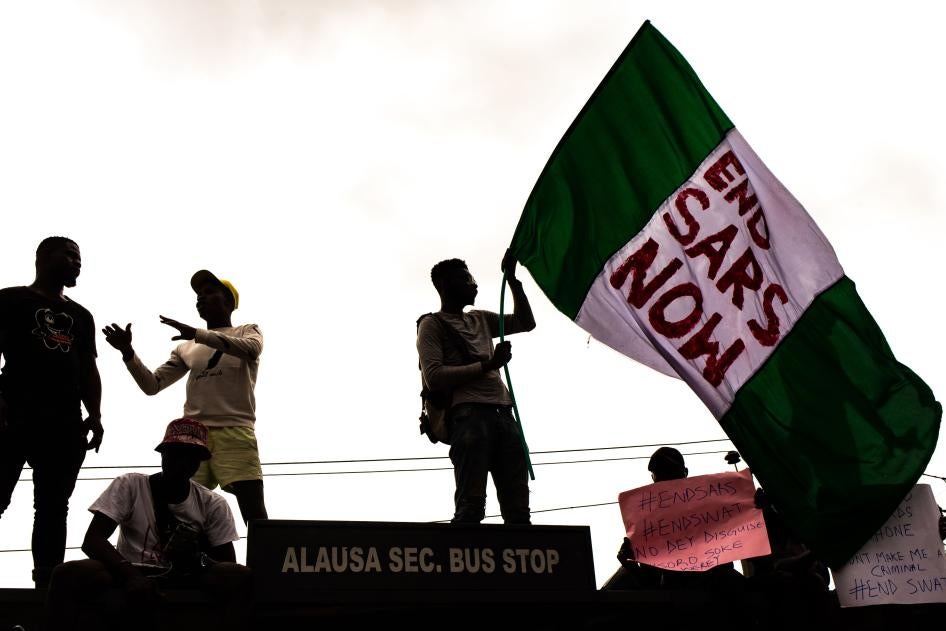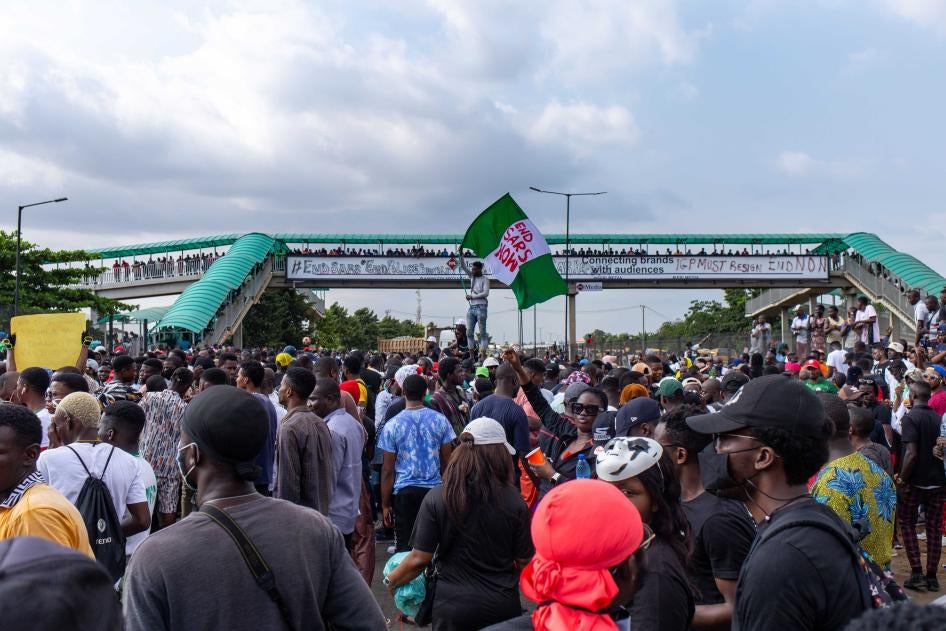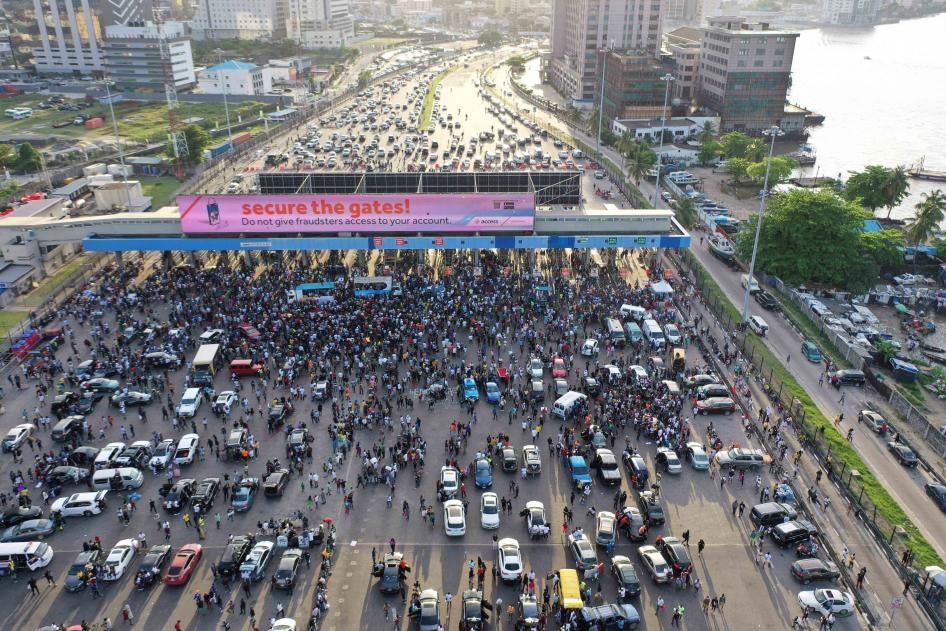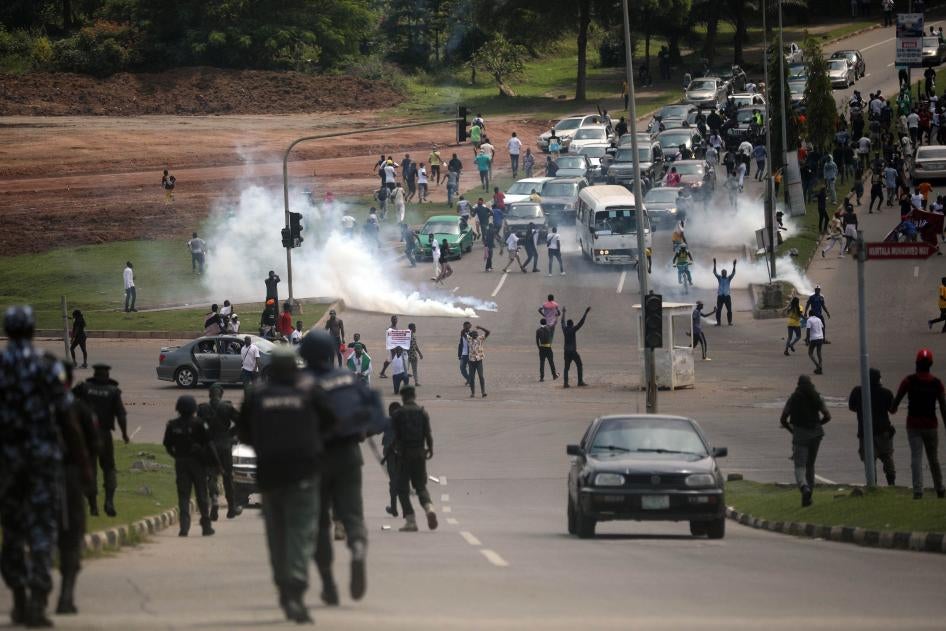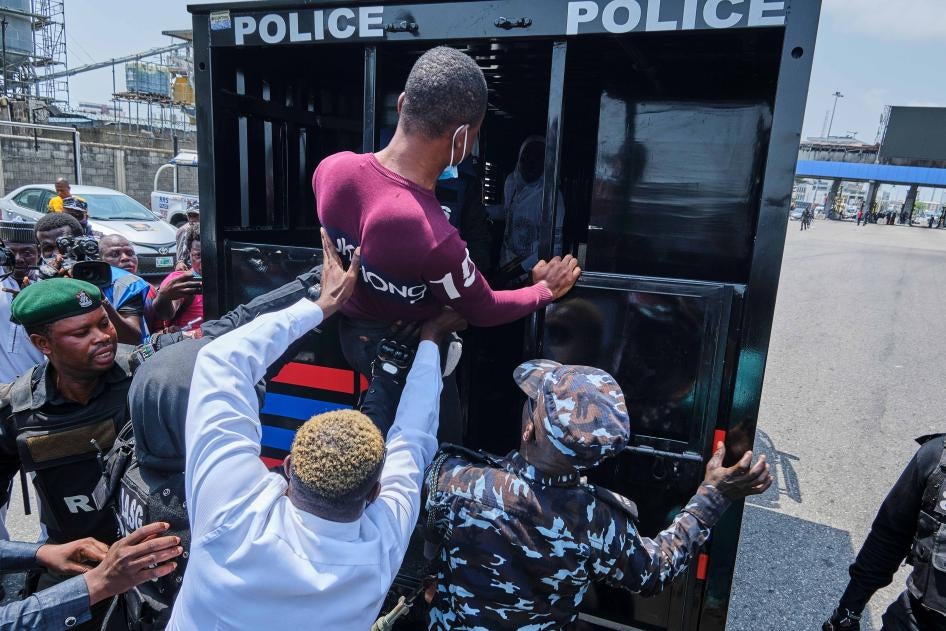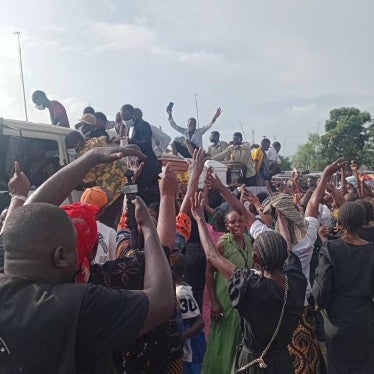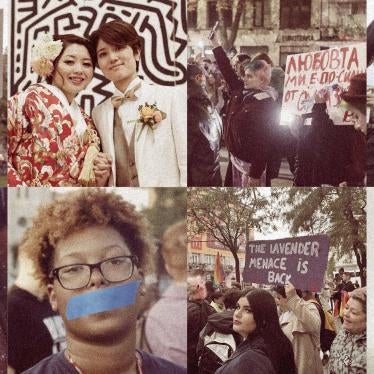(Abuja) – The victims are still awaiting justice a year after security forces violently suppressed protests calling for an end to police brutality in Nigeria, Human Rights Watch said today. The prospects for accountability remain inconclusive and bleak. Nigerian authorities should take concrete and decisive steps to ensure that those implicated in abuses against protesters are held accountable.
In October 2020, young people across Nigeria took to the streets calling for disbanding an abusive police unit known as the Special Anti-Robbery Squad (SARS) and for ending brutality in a movement tagged #EndSARS. Security forces responded with excessive force, including gunfire, which resulted in death and serious injuries.
“Nigerian authorities should clearly demonstrate that they are serious about holding those responsible for abuses against protesters to account,” said Anietie Ewang, Nigeria researcher at Human Rights Watch. “Failure to pursue justice will strengthen the culture of impunity and reinforce the perceptions that brought protesters to the streets in the first place.”
Between October 2020 and August 2021, Human Rights Watch interviewed 54 people, including victims and their family members, protesters, protest supporters, representatives of civil society groups, medical service providers, political analysts, and journalists, on how the crackdowns unfolded and how the victims have been affected. Human Rights Watch also wrote letters to the Nigerian Police Force and the Nigerian Army to share findings and ask questions about officers’ conduct during the protests but has yet to receive a response.
One of the worst crackdowns was at the Lekki Toll Gate in Lagos on October 20, when army officers arrived in about five trucks and surrounded a large group of protesters holding a peaceful sit-in. The soldiers trapped the protesters, using a tactic known as “kettling,” then fired in the air and at the crowd. Kettling is a method of confinement used by police to trap a crowd of people in a specific space.
After the soldiers left, police officers arrived and, according to multiple witnesses, began shooting at protesters who had not managed to flee. Witnesses described a gruesome scene with bloodied, lifeless bodies on the ground and many others with gunshot wounds whom they tried to rush to hospitals.
Human Rights Watch was not able to ascertain the total number of those killed by the military during this incident. Witnesses said that they saw what appeared to be at least 15 lifeless bodies and that military officers had taken away at least 11. Witnesses also reported that the police shot at least two protesters and took their lifeless bodies away with them.
People who survived the use of excessive force at Lekki and other locations had tales of woe about the aftermath. Human Rights Watch confirmed that a 32-year-old generator mechanic died on the way to the hospital after the military shot him in the chest and stomach. Another protester, Wisdom Okon, remains missing. Their loved ones said that efforts to report what happened to the police or gather information from the authorities have been futile.
The brother of the man who died said:
“We feel bad but there is nothing we can do because we can’t fight the government. We tried to make a report at the police station after he died but they [the police] didn’t allow anybody near their stations, not even close to the gate, talk less of [reaching] the counter [inside the station] to make a report.”
Peace Okon, the sister of the missing man, said that she has been looking for her 18-year-old brother since October 20, 2020, when he was last seen by their neighbor at the Lekki Toll Gate protest site around 4 p.m. She suspects he may have been shot or injured at the toll gate and has since visited several hospitals, mortuaries, police stations, and a prison in Lagos to try to find him, to no avail.
She said officers at the police stations and the prison she visited wanted bribes before helping her. She said:
“I can’t report to anybody that I know will do the right thing. My mom has developed high blood pressure, she calls me weeping, asking for her son… I am helpless and I feel responsible because I brought him to Lagos [from our village]. This our country is not fair, there is no justice for the ordinary man, the government has forgotten about those people who were killed or missing from Lekki Toll Gate.”
Human Rights Watch interviewed and inspected the wounds of four people who said they had gunshot wounds and interviewed a doctor who confirmed that three people brought to the hospital where he works had limbs amputated after being shot at Lekki.
A 30-year-old events planner shot in his upper thigh said: “I am still alive, but we lost others in the struggle just because youths decided to speak up. If nothing is done to those that shot us, then it really means that our lives are nothing in this country.”
Despite repeated calls for accountability for abuses committed against protesters, Human Rights Watch has not been able to determine that any members of the security forces or police have been arrested or tried for their roles in the crackdown.
The Lagos State Judicial Panel of Inquiry and Restitution for Victims of SARS Related Abuses was set up on October 19, 2020, alongside other state panels to receive and evaluate public complaints of police brutality and extrajudicial killings and to recommend compensation for victims and officers for prosecution. The mandate of the panel was later extended to include investigations into the Lekki tollgate incident.
The panel is expected to conclude its work on October 19, but it has no authority to make binding decisions and can only present its findings and make recommendations to the Lagos State governor. If the recommendations are adopted, they can be enforced as a judgment of the State High Court.
However, a Nigerian lawyer and security sector reform expert told Human Rights Watch that courts cannot automatically assume jurisdiction over police or military officers. Charges can only be brought against them after internal disciplinary processes lead to their being fired.
Despite the slow progress, justice could still be achieved, but the full cooperation and support of the federal government, the Lagos State government, and the Nigerian military and police force will be critical. Officers who have been summoned by the panel should testify and answer necessary questions, and the Lagos State government should also commit to releasing the full report of the panel’s findings and recommendations. The federal government should then ensure that those implicated in abuses against protesters, including as a matter of command responsibility, are brought to justice.
Beyond accountability for abuses during the #EndSARS protests, the authorities should tackle the systemic problems that foster a culture of impunity in the security sector and push forward comprehensive and meaningful reforms to end the abuses and injustices Nigerians have long experienced.
“Nigeria’s authorities should take effective steps toward accountability to show victims that their loss, pain, and suffering is not in vain,” Ewang said. “Anything less will worsen distrust of the government and reinforce the perception that the lives of citizens do not matter.”
For more information on the human rights abuses during the #EndSARS protests and accountability efforts, please see below.
Birth of the 2020 #EndSARS Movement
The Nigerian police force has a long history of unethical, corrupt, and criminal conduct. Its Special Anti-Robbery Squad (SARS), formed in 1992 to combat armed robbery and other violent crimes, was especially notorious for brutality against citizens. It has repeatedly been accused of committing the crimes it was created to respond to, and its members have been implicated in widespread human rights abuses, including extrajudicial killings, torture, arbitrary arrests, unlawful detention, extortion, and sexual violence. Several promises and commitments by the authorities to investigate alleged abuses by the group and ensure accountability yielded no meaningful results.
On October 3, 2020, a video surfaced online in which people said that SARS officers had just shot a young man in front of a hotel in Ughelli, Delta State, and fled with his vehicle, leaving him by the roadside to die. This led to a public outcry on social media and revived calls, especially on Twitter, to disband SARS using the #EndSARS hashtag. Despite a statement from the police authorities in Delta denying officers shot at the victim, whom they said was still alive, the campaign gained momentum as people shared other stories, photos, and videos of abuses by SARS officers.
A group of young people led by a social media influencer known as Rinu Oduala decided to organize protests in Lagos, starting on October 7. Thousands of people joined them, while others took to the streets in other cities across the country, including Abuja, Kano, Ibadan, Port Harcourt, and several others.
Responding to the protests, the Nigerian authorities disbanded SARS on October 11 and made several commitments toward justice, accountability, and police reform. But while these commitments were being announced, officers on the streets were attacking peaceful protesters with brutal force.
Apparent Use of Excessive Force
During protests between October 7 and 20, 2020, in states including Ogun, Oyo, and Lagos, and in Abuja, the nation’s capital, security forces repeatedly responded with what appeared to be excessive force, using gunfire, water cannons, and teargas fired at close range.
Abuja, October 11
Police dispersed protesters marching toward the police headquarters with teargas and water cannons. Human Rights Watch interviewed three people who participated in or were in the vicinity of the protests and were badly beaten by officers.
Human Rights Watch also analyzed several videos posted on social media by protesters or filmed by journalists documenting the incident. In one video obtained and verified by Human Rights Watch, a police water cannon truck can be seen projecting a strong force of water on dozens of protesters, some of whom were on the ground, kneeling, or standing and holding hands with others while struggling to maintain their balance. Several police officers can also be seen standing around the truck, some holding sticks.
The police also used water cannon trucks to chase protesters on foot and in their cars, projecting forceful bouts of water on them at close range. Some protesters clung to moving vehicles in an effort to escape. In one video obtained and verified by Human Rights Watch, three protesters fell from moving vehicles which were being closely pursued by the police water cannon truck, and narrowly missed being crushed when the truck came to a stop right in front of them.
Lekki Toll Gate, October 20
In the most violent incident, which brought an end to the protests on October 20, soldiers and police officers opened fire on protesters at the toll gate that connects Lekki, a Lagos suburb, with the city’s main business district.
Peaceful Sit-in
The Lekki Toll Gate was one of the most vibrant protest locations in the country. Hundreds of people from all backgrounds showed up each day, starting on October 10, and many stayed overnight. Protesters were motivated by speeches, music, and other performances. Individuals and groups supporting the protests provided food, water, medical kits, masks, hand sanitizer, mobile toilets, raincoats, and money to cover logistics.
A 27-year-old comedian and actor told Human Rights Watch that he came with his colleague from Ikorodu, a community about 68 kilometers away. “We decided to come all the way because we saw from social media that it was the powerhouse,” he said.
Shootings by the Military
On October 20 Governor Babajide Sanwo-Olu announced a statewide curfew beginning at 4 p.m. to restore order as “arsonists, hoodlums, and anarchists continue to hide under the #EndSARS protest to unleash mayhem in the state and wantonly disrupt citizens lives and property.” The curfew was later delayed to 9 p.m. after many people complained that it was impossible to get home before 4 p.m. given the traffic in Lagos. Although some protesters at the Lekki Toll Gate left following the announcement of the curfew, many stayed. “For us, the curfew meant we should stay in place and not move around Lagos, and we were prepared to do just that,” said Akin Olaoye, a prominent organizer.
Sixteen people at the scene said that between 6:30 p.m. and 7 p.m. – well before the 9 p.m. curfew – men dressed in military fatigues arrived in about five trucks and began firing in the air and at protesters. As the soldiers were closing in on the protesters, organizers told people to come together, sit on the ground, and wave their flags to show they were peaceful. Witnesses said that some of the soldiers’ trucks were labeled with “OP MESA,” referring to Operation MESA, a joint internal security platform of the army, the navy, and the air force. It operates in synergy with the police and is meant to complement police efforts to fight crime in Lagos State.
About 40 minutes to an hour after the military arrived and began shooting, more soldiers led by a senior officer who witnesses identified as Army Brigadier General F.O. Omata arrived. The shooting, which had become sporadic, then stopped. “Omata came to the stage, trying to calm people down,” said one 34-year-old protester. “He asked people to leave, saying there was a curfew in place, but we responded by telling him we were not leaving and asking him why they were killing us,” said a 28-year-old man who had been part of the security team at the toll gate.
Protesters said they proceeded to carry people who had been injured or shot, including some apparently lifeless bodies, put them together in front of the soldiers, telling the soldiers that they were responsible for the victims’ deaths. The soldiers took many of the bodies away with them.
A 24-year-old construction worker said that he was among those taken away by military officers, who thought he was dead. “I was faint and lifeless, but I could make out what they were saying and doing,” he said. “We were taken to the military hospital, and from there, six of us were taken to the general hospital in Marina. I am not sure what happened to the other five, but they didn’t follow us from the military hospital.” He regained consciousness fully at the general hospital after seven hours and left the hospital early the next morning because he was afraid the military would come back for him.
Five people said they saw military officers with flashlights picking up bullet shells and bullets before the officers left. “I saw the soldiers picking up bullets one by one so they could cover up what they did,” said one protester who works as a security guard. A 24-year-old protest organizer said that she also picked up bullets to keep them as evidence, including six casings and one live round. Human Rights Watch saw and analyzed these, which appear to be standard ammunition.
The Nigerian army initially responded to news of the shooting by labeling posts on the incident as fake news on all its verified Twitter accounts. They changed their position on October 27, when a spokesperson for the 81st division of the Nigerian army, which has its headquarters in Lagos State, said its soldiers were deployed on orders from the Lagos State government to enforce the statewide curfew. He denied that the troops shot at protesters, however. The Lagos State governor admitted in a televised CNN interview that soldiers had shot at protesters at the Lekki Toll Gate and said that two dead bodies were identified following the incident. He however denied any involvement in sending soldiers to the Lekki Toll Gate.
Later, during a session of the Lagos judicial panel of inquiry on November 8, 2020, the commander of the 81st division’s military intelligence brigade, Ibrahim Taiwo, stated that the officers at the scene had both blank and live bullets and only shot the blanks after they were attacked by “hoodlums” who pelted them with stones and injured a soldier on the lips.
Although the judicial panel is empowered to summon anyone in Nigeria, the army officer who was identified as leading the team deployed to the Lekki Toll Gate and other senior officers refused to appear before the panel, without consequences. Following the panel’s decision to reopen the Lekki Toll Gate in February, Oduala, a prominent protest organizer who was invited to serve as a member of the panel, resigned in protest. Oduala told Human Rights Watch that she strongly opposed reopening the toll gate before the investigation into the shooting of protesters was concluded and yielded meaningful results. These incidents coupled with Nigeria’s poor history with previous panels that failed to bring about meaningful justice, have undermined confidence in the Lagos panel.
Shootings by the Police
Five witnesses said that about 45 minutes to an hour after the soldiers left, about 15 police officers from the Maroko police station, which covers the Lekki Toll Gate area, arrived in about three trucks, and began shooting at some of the remaining protesters, causing many to flee. They were led by the station’s commander, witnesses said, and most were dressed casually in green trousers and black t-shirts or jackets, the typical attire of SARS officers.
Three people said that they recognized the commander, known as the divisional police officer, or DPO, who was wearing a white outfit, because they lived in the waterside informal community close to and under the jurisdiction of the Maroko police station. A 23-year-old student who lives in the community and witnessed the shooting by the police at the tollgate said:
I had an issue in the past that required me to go to the Maroko Police Station. The DPO handled my case during that incident, so I know him well. He was wearing white up and down that day of the shooting. I saw him clearly take out a pistol and shoot one man in the head, who was already injured and could not run. The DPO had a pistol, but the other officers had bigger guns. I saw them take about three bodies when they left that night.
A 35-year-old driver said that he saw the police take the lifeless bodies of two people they had shot with them when they left the area.
When Human Rights Watch contacted the DPO, he refused to respond to questions, saying he was not permitted to speak on the issue.
The Aftermath: Deaths, Injuries, Disappearances, and Harassment of Victims’ Family Members
The 35-year-old comedian was shot in the chest as he was trying to find his colleague in the crowd after the military officers opened fire. He passed out and was rushed to General Hospital Marina by other protesters. A 38-year-old construction worker who was shot twice in his neck and back said that he had joined the protest to fight for a better future for his children. A 30-year-old man was shot in his left upper thigh. The bullet penetrated the phone in his pocket, saving his leg from much of the impact. He told Human Rights Watch that he saw more than 10 others with gunshot wounds at Reddington hospital in Lekki, where he was first taken on the day of the incident.
The 35-year-old driver said he saw about 10 people with gunshot wounds at the scene, including four of his friends. He said he helped administer first aid to three people, using clothes to stop the blood oozing out of their wounds. A doctor at one of the hospitals where protesters were taken said that three patients from the Lekki Toll Gate, all in their twenties, had limbs amputated: one lost his leg, and the other two each lost an arm.
The Lagos State government reported that two people died during the Lekki tollgate incident, a figure that local rights groups and other activists rejected as far too low.
Mass Arbitrary Arrests and Incommunicado Detention of Protesters
In response to the protests, police arrested dozens of protesters and held them incommunicado for many hours or days, denied them access to lawyers, and brought trumped-up charges against several of them. Adetola Onayemi and Modupe Odele, two young lawyers who established the EndSARS Legal Aid Program, said that they received reports that 352 protesters were arrested during the protests in October 2020 and that they have helped to secure the release of 337 protesters in 13 states.
“We saw from the cases we handled that the police commanders are so powerful and there is no central accountability system, so the police officers can do whatever they want to people they arrest – they can transfer them anywhere or even kill them,” Odele said. “That’s why we tried to deploy lawyers as quickly as we could. Those first few minutes are crucial or else people can get lost or disappear in the system.”
Other Punitive Measures
Nigerian authorities froze the bank accounts of individuals and groups donating, collecting, or disbursing funds to support the protesters and placed travel restrictions on prominent supporters of the protests.
Media houses were fined for using footage from social media in their coverage of the protests, and government officials repeatedly called for government regulation of social media, citing the role platforms like Twitter played in galvanizing support for the protests. In June, the Nigerian authorities banned access to Twitter after the social media platform deleted a tweet from President Buhari which it said violated its rules. While attempting to justify the ban, Nigeria’s information minister cited the role Twitter played in the #EndSARs movement.
Applicable Legal Standards
Nigeria’s constitution protects the right to free expression, press freedom, peaceful assembly, and association. Nigeria has ratified the African Charter on Human and Peoples’ Rights (ACHPR) and the International Convention on Civil and Political Rights (ICCPR) which guarantee the right to life for all, and the rights of individuals to associate and assemble freely with others.
Under the United Nations Basic Principles on the Use of Force and Firearms by Law Enforcement Personnel, law enforcement officials should make use of nonviolent means before resorting to force and avoid use of force to disperse nonviolent protests, regardless of whether the authorities deem the protests illegal. Any use of force by law enforcement must be preceded by clear warnings and should only be used if other measures to address a genuine threat have proved ineffective or have no likelihood of achieving the intended result. When using force, law enforcement should exercise restraint and act proportionately, considering both the seriousness of the offense and the legitimate objective to be achieved.
